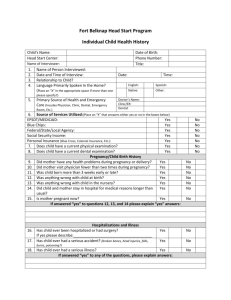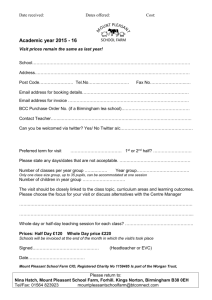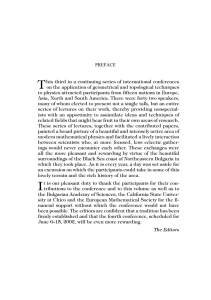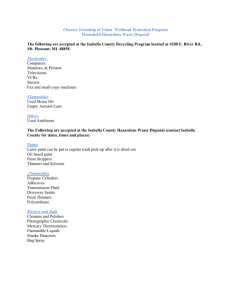Session 7: Introduction to Pleasant Events and your Mood
advertisement
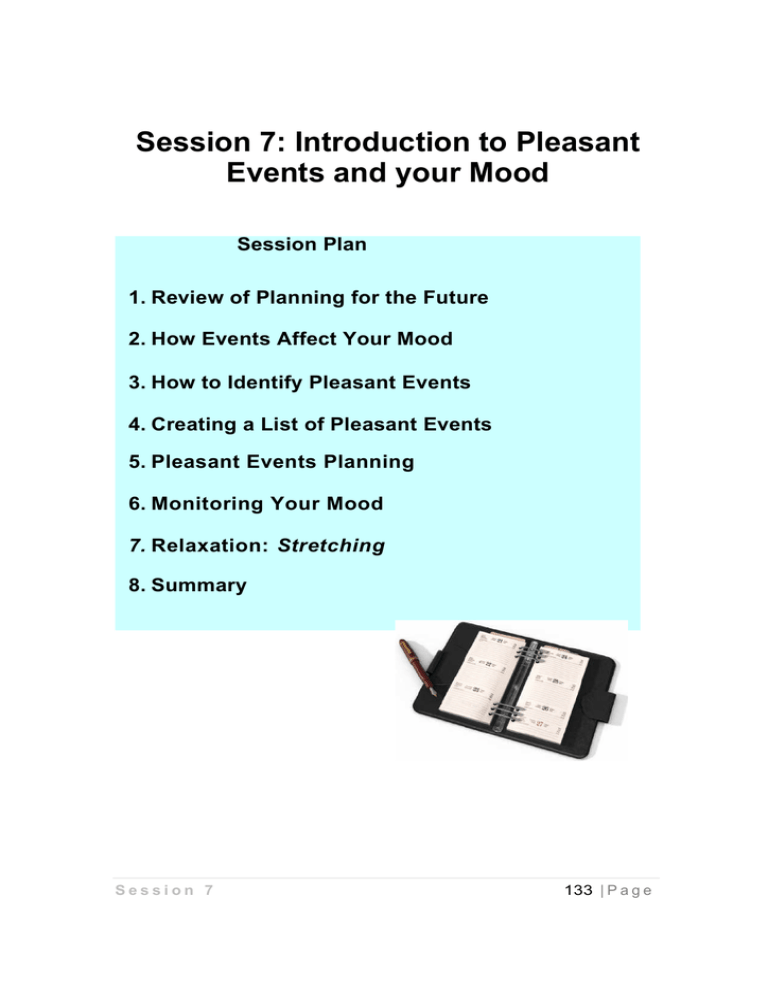
Session 7: Introduction to Pleasant Events and your Mood Session Plan 1. Review of Planning for the Future 2. How Events Affect Your Mood 3. How to Identify Pleasant Events 4. Creating a List of Pleasant Events 5. Pleasant Events Planning 6. Monitoring Your Mood 7. Relaxation: Stretching 8. Summary Session 7 133 | P a g e Review of Planning for the Future Leader: Review Planning for the Future – review future possible stressful situation from last week. If they have indicated they need more information, talk with them about from where this could be obtained. Review Thought and Behaviour Records Session 7 134 | P a g e How Events Affect Your Mood Although being a carer is time consuming, it is important that you make the time for activities you enjoy. This is because if all your activities are limited to caring, you may begin to feel burned out and frustrated. For example, feeling down is often related to having too few pleasant events. A lack of balance between unpleasant and pleasant events can make you feel like you have no control. You may think “It seems like there’s nothing I can do to make things better.” However, you can feel better by making sure your day has a few events that bring you pleasure. We can make choices about many of the events that occur in our lives. Increasing pleasant events can help reduce stress and therefore make you feel more able to care. Session 7 135 | P a g e What Counts As A Pleasant Event? Pleasant events don’t have to be long or need a lot of planning. They aren’t just big events like holidays. Reading the newspaper, a leisurely cup of coffee, gardening or talking to a friend can all be pleasant activities. Key Point: Anything you like to do is a pleasant event List two activities that are pleasant for you: a. b. Adding pleasant events to your daily life can be difficult. You may think “I don’t have the time to do pleasant activities!” or feel guilty about making time for yourself or having time apart from the person you care for. These can be barriers but it is important to overcome them. Being a good carer means taking care of yourself too! Session 7 136 | P a g e Pleasant Events for You and Your Relative Pleasant events can be for you alone or for you and your relative. It is important to have pleasant activities to do with the person you care for. This can be hard since you may have many tasks to do as a carer, but it is valuable if you can continue to enjoy each other’s company. I’d like to work with you to develop a list of pleasant events that you can enjoy together, and things you can enjoy by yourself. Session 7 137 | P a g e Here are some examples of pleasurable events, not all of these activities will be for you. Take a few moments to look over this list and tick the activities you think you would enjoy either together or separately. Activities You You and your relative Listen to music Go to the shops Go for a walk Read/listen to books, newspapers, magazines or spiritual texts Go out for coffee or to eat with friends or family Cook or bake Write letters or cards etc Drawing, painting, doing crafts Exercise e.g. jogging, yoga, cycling, football Go to the cinema or watch a film Go for a drive Go to the park with a picnic Have friends over Gardening / DIY Be with children / grandchildren Listen to the radio Watch your favourite TV programme Watch wildlife or be around animals or pets Look at photos Go to place of worship Watch sports Recall or discuss happy memories Dance Have a leisurely bath Chat to friends or family on the phone Spend time on the computer Play cards, computer games, crosswords or puzzles Talk about family or current events Buy a ready prepared meal or take away Get your hair / nails done Massage Have a glass of wine or beer Bingo Other activity: Other activity: Highlighting these activities and doing two or three of them each day can make a huge difference to how you feel. Session 7 138 | P a g e Creating a List of Pleasant Events Rule A: Start small and be simple. The most important thing to remember is to choose events that you can do everyday or a few times a week. You may enjoy travelling, but realistically you cannot take a trip every day. A smaller and more realistic activity would be going to the shops, cycling or walking. Rule B: Focus on events you want to do more often . Let’s think of four pleasant activities for you Leader: use list from page before if necessary 1 2 3 4 Session 7 139 | P a g e Creating a List of Pleasant Events for You and Your Relative It can be helpful to plan activities or events that are manageable and achievable. Think about events you used to enjoy together in the past. Is it possible to still do those activities? If not, can they be changed in any way? For example, if you used to take long walks together, can you now take short walks? As long as you find things your relative enjoys and is able to do, you will be helping them to feel better. Things to remember when selecting and planning activities for your relative: Don’t force them to participate: Encourage or reward him/her often. Try to think of things that are similar to some hobbies, interests, or games they used to enjoy. Have a few activities available, so if they become bored you can switch easily. Plan to do activities in short bursts. Try to involve other friends or family if at all possible. Activities that involve movement can be good, since people are often restless and have relatively short attention spans. There is no harm if your relative enjoys crafts, games, or music that are simpler than before. Let’s think of four pleasant activities for you and your relative Leader: use list from page before if necessary 1 2 3 4 Session 7 140 | P a g e Pleasant Events Planning Some activities require more planning than others. Because we want you to be successful in planning pleasant events for both you and your relative, we have put together a list of questions you may ask yourself beforehand so that things will go as smoothly as possible. It may be that planning beforehand will help you manage to do pleasant activities. Take a look at these questions: Leader: Encourage carer to work through the questions for one activity they plan to do in the next week. Pleasant Activity: Materials or preparation needed When it will take place? How often can it be done? How much time will it take? Session 7 141 | P a g e Monitoring Your Mood In order to understand the difference pleasant events make to you, I want you to keep track of how you are feeling. This means asking yourself, “How am I feeling today?” By keeping a daily record of your feelings, this will allow you to identify whether your mood follows a particular pattern. The number 1 represents the lowest you could possibly feel. The number 9 represents the best you could possibly feel. Record a number on your pleasant events sheet (on the next page) at the end of each day. This number will represent the way you felt on that day. You will rate your mood on a scale 1 to 9. When you fill in this number at the end of each day, think about how you felt overall. Most of us have lots of ups and downs over the course of the day, so try to take an average of these feelings. Next to your mood score for each day, is a space for any comments about that day’s events that may have contributed to your mood. Leader: Fill in the days and events you wrote down before for the table on the next page now. Ask them to use these during the week. Complete the first line as an example. Session 7 142 | P a g e Pleasant Events For My Relative and Me Events for Me Day a ................................................ Events for My Relative and Total My Events Mood Me Today Score Comments a............................................. (1-9) b ................................................ b ............................................ c ................................................ c............................................. d ................................................ d ............................................ Which events (a,b,c,or d) Which events (a,b,c,or d) Example Session 7 143 | P a g e BLANK PAGE Session 7 144 | P a g e Relaxation: Stretching Leader: Ask if they managed to try last week’s exercise. Ask what their experience was like. Discuss barriers that may have prevented practice. Praise all attempts. Check with the person that you are working with that they are fit and well enough to do these exercises i.e. do not feel dizzy or have funny turns when standing. If so do it all sitting or another relaxation exercise Introduction Simply stretching tired muscles can go a long way toward reducing tension and stress. Stretching exercises can be used almost anywhere, at any time, for as long as you want, so they can be an especially convenient relaxation technique for carers. It is important to do stretching exercises that feel good to you. As we practise this today, please tell me if you experience any discomfort and we will stop and try something else. Stress Rating Before Exercise First, please rate your level of stress or tension right now, before we practise the Stretching Exercise. On a scale of 1 to 5, how would you rate your tension? Session 7 145 | P a g e Stretching: Practice Session Script for Leader: “Today, we will do a few stretching exercises that will help you relax. First, let’s start by standing up, or if you prefer, you may choose to do this exercise in your chair. Whatever is the most comfortable for you is all right. Take a deep signal breath, all the way down to the bottom of your stomach, (pause 2s) and slowly let it out. Feel the tension drain from your body. (pause) Take one more breath and hold it for a moment (pause 2s) and let it out slowly. With each breath you are becoming more and more relaxed. Now, gently reach your arms out to the sides, as though you were trying to touch the walls. Relax your shoulders and stretch yourself a little. Gently reach your arms out in front of you. Feel the muscles in your back and shoulders loosen up. Stretch out in front a little further. And now reach up as high as you can. Push up your arms towards the sky, as if you were trying to reach the sun. Again, reach your arms out to the sides as though you were trying to touch the walls, as though you were trying to push the walls outward. Reach out in front of you. Feel your muscles in your back and shoulders become looser and less tense. Reach up toward the sky one more time. Reach as high as you can. Try to touch the sun. Session 7 146 | P a g e Lower your arms to your sides. Now, roll your shoulders back. Feel the tension drain form your body. Roll your shoulders back again. One more time roll your shoulders back. Now roll them forward. Roll them forward again. One more time forward. Now shrug your shoulders, lifting them up and then pushing them down. Shrug your shoulders again. Shrug them one more time. Now another take in a deep and refreshing breath, and exhale all of the tension in your body. To complete this session, take one more breath... and exhale, letting go of any remaining tension.. Are you feeling calmer and more relaxed now? If not, consider completing this exercise a second time.” Session 7 147 | P a g e Stress Rating after Exercise Now rate your level of stress or tension after practicing the Stretching Exercise. On a scale of 1 to 5, how would you rate your tension? 1. Did your level of tension change? 2. What was this experience like for you? 3. Can you think of a time when you could use the stretching exercise (i.e., during a stressful caregiving situation)? Leader: Praise carers for any success they had with the exercise Encourage carers to practise stretching at least once per day this week Session 7 148 | P a g e Summary: Today we have talked about: Being aware of your feelings/mood. The connection between mood and Pleasant Events. Increasing Pleasant Events as a way to improve your mood. Relaxation: Stretching. FOR NEXT WEEK: √ Pleasant Events Tracking Form: Please complete the form on page 140 each day this week. Try to fill it out at the end of each day. Feel free to add new Pleasant Events or change the ones you have written down. √ Relaxation: Please try to practise the Stretching exercise that we have just done. √ Optional Exercises (recommended): Behaviour Record: Please complete the Behavioural Record, on page 147, when your relative’s target behaviour occurs. We understand it may be difficult to complete the record each time, but please complete it as frequently as possible. Thought Record: When a situation occurs that stresses you, please record your unhelpful thoughts and challenge and replace them with more helpful thoughts. Use the Thought Record on page 148. Session 7 149 | P a g e Optional Exercise: Behaviour Record Please use this Record to write down something your relative does (or that you do) that upsets you. Date and time People Present Trigger Behaviour Reaction The strategy you used to change the behaviour was: What happened when you tried using this strategy? Session 7 150 | P a g e Optional Exercise: Thought Record Situation Describe the events that led to your unpleasant feelings. Session 7 Current thoughts Feelings Identify your thoughts in the situation. What are you feeling? (sad, angry, anxious, etc) Challenge & replace with more helpful thoughts What is a more helpful way of thinking about the situation? New feelings What are you feeling now? (sad, angry, anxious, etc) 151 | P a g e Blank Page Session 7 152 | P a g e

